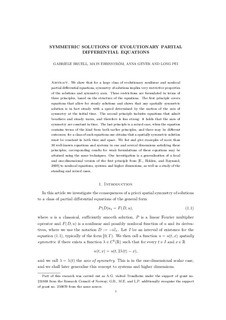| dc.contributor.author | Ehrnstrom, Mats | |
| dc.contributor.author | Bruell, Gabriele | |
| dc.contributor.author | Pei, Long | |
| dc.contributor.author | Geier, Anna | |
| dc.date.accessioned | 2017-09-22T09:09:00Z | |
| dc.date.available | 2017-09-22T09:09:00Z | |
| dc.date.created | 2017-08-31T11:28:12Z | |
| dc.date.issued | 2017 | |
| dc.identifier.citation | Nonlinearity. 2017. 30 (10) | nb_NO |
| dc.identifier.issn | 0951-7715 | |
| dc.identifier.uri | http://hdl.handle.net/11250/2456193 | |
| dc.description.abstract | We show that for a large class of evolutionary nonlinear and nonlocal partial differential equations, symmetry of solutions implies very restrictive properties of the solutions and symmetry axes. These restrictions are formulated in terms of three principles, based on the structure of the equations. The first principle covers equations that allow for steady solutions and shows that any spatially symmetric solution is in fact steady with a speed determined by the motion of the axis of symmetry at the initial time. The second principle includes equations that admit breathers and steady waves, and therefore is less strong: it holds that the axes of symmetry are constant in time. The last principle is a mixed case, when the equation contains terms of the kind from both earlier principles, and there may be different outcomes; for a class of such equations one obtains that a spatially symmetric solution must be constant in both time and space. We list and give examples of more than 30 well-known equations and systems in one and several dimensions satisfying these principles; corresponding results for weak formulations of these equations may be attained using the same techniques. Our investigation is a generalisation of a local and one-dimensional version of the first principle from Ehrnström et al (2009 Int. Math. Res. Not. 2009 4578–96) to nonlocal equations, systems and higher dimensions, as well as a study of the standing and mixed cases. | nb_NO |
| dc.language.iso | eng | nb_NO |
| dc.publisher | IOP Publishing | nb_NO |
| dc.title | Symmetric solutions of evolutionary partial differential equations | nb_NO |
| dc.type | Journal article | nb_NO |
| dc.type | Peer reviewed | nb_NO |
| dc.description.version | acceptedVersion | nb_NO |
| dc.source.volume | 30 | nb_NO |
| dc.source.journal | Nonlinearity | nb_NO |
| dc.source.issue | 10 | nb_NO |
| dc.identifier.doi | 10.1088/1361-6544/aa8427 | |
| dc.identifier.cristin | 1490150 | |
| dc.relation.project | Norges forskningsråd: 231668 | nb_NO |
| dc.relation.project | Norges forskningsråd: 250070 | nb_NO |
| dc.description.localcode | © 2017 IOP Publishing Ltd & London Mathematical Society. This is the authors' accepted and refereed manuscript to the article. Locked until 2018-09-18 due to the copyright restrictions. | nb_NO |
| cristin.unitcode | 194,63,15,0 | |
| cristin.unitname | Institutt for matematiske fag | |
| cristin.ispublished | false | |
| cristin.fulltext | postprint | |
| cristin.qualitycode | 1 | |
